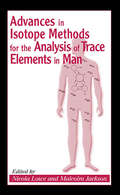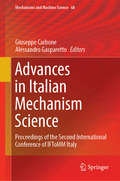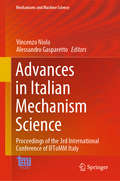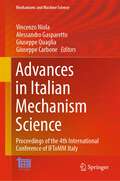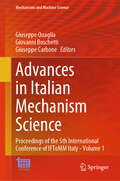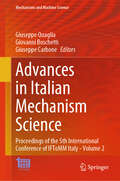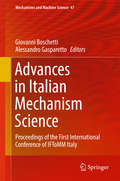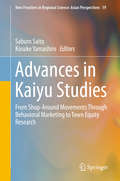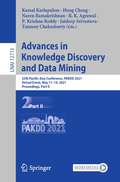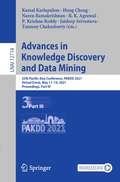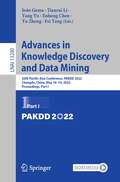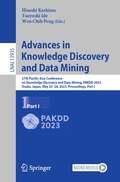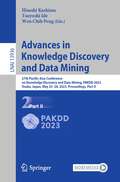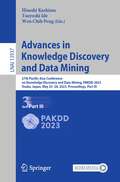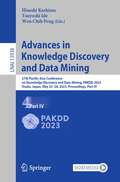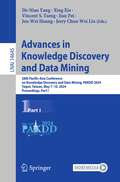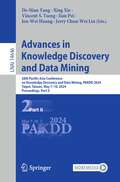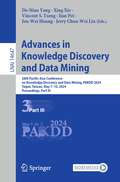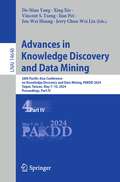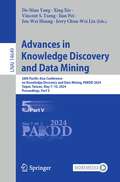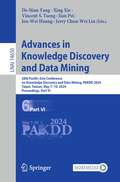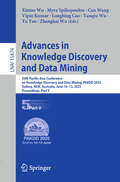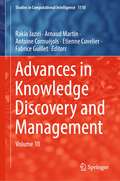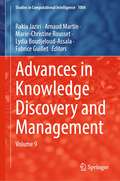- Table View
- List View
Advances in Irrigation Agronomy
by M.K.V. CarrIrrigation has been used for thousands of years to maximize the performance, efficiency and profitability of crops and it is a science that is constantly evolving. This potential for improved crop yields has never been more important as population levels and demand for food continue to grow. Recognising the need for a coherent and accessible review of international irrigation research, this book examines the factors influencing water productivity in individual crops. It focuses on nine key plantation/industrial crops on which millions of people in the tropics and subtropics depend for their livelihoods (banana, cocoa, coconut, coffee, oil palm, rubber, sisal, sugar cane and tea). Linking crop physiology, agronomy and irrigation practices, this is a valuable resource for planners, irrigation engineers, agronomists and producers concerned with the international need to improve water productivity in agriculture in the face of increased pressure on water resources.
Advances in Isotope Methods for the Analysis of Trace Elements in Man (Modern Nutrition)
by Nicola Lowe Malcolm JacksonThere is increasing evidence that even minute amounts of trace elements can have profound effects on the human body. Advances in Isotope Methods for the Analysis of Trace Elements in Man describes new methods that are being developed to understand normal and abnormal trace element nutrition and metabolism. This book includes a wealth of pr
Advances in Italian Mechanism Science: Proceedings Of The First International Conference Of Iftomm Italy (Mechanisms and Machine Science #47)
by Giuseppe Carbone Alessandro GasparettoThis book constitutes the Proceedings of the Second International Conference of IFToMM ITALY, held in Cassino, Italy, in 2018. The main topics of the workshop include: Computational Kinematics, Dynamics of Machinery, Gearing and Transmissions, Multibody Dynamics, Mechatronics, Mechanism Design, Tribology, Vibration, Industrial and non-Industrial Applications.
Advances in Italian Mechanism Science: Proceedings of the 3rd International Conference of IFToMM Italy (Mechanisms and Machine Science #91)
by Alessandro Gasparetto Vincenzo NiolaThis book presents the proceedings of the 3rd International Conference of IFToMM ITALY, held online on September 9-11, 2020. It includes peer-reviewed papers on the latest advances in mechanism and machine science, discussing topics such as biomechanical engineering, computational kinematics, the history of mechanism and machine science, gearing and transmissions, multi-body dynamics, robotics and mechatronics, the dynamics of machinery, tribology, vibrations, rotor dynamics and vehicle dynamics. A valuable, up-to-date resource, it offers an essential overview of the subject for scientists and practitioners alike, and will inspire further investigations and research.
Advances in Italian Mechanism Science: Proceedings of the 4th International Conference of IFToMM Italy (Mechanisms and Machine Science #122)
by Giuseppe Carbone Alessandro Gasparetto Giuseppe Quaglia Vincenzo NiolaThis book presents the proceedings of the 4th International Conference of IFToMM ITALY (IFIT), held in Naples, Italy on September 7-9, 2022. It includes peer-reviewed papers on the latest advances in mechanism and machine science, discussing topics such as biomechanical engineering, computational kinematics, the history of mechanism and machine science, gearing and transmissions, multi-body dynamics, robotics and mechatronics, the dynamics of machinery, tribology, vibrations, rotor dynamics and vehicle dynamics. A valuable, up-to-date resource, it offers an essential overview of the subject for scientists and practitioners alike, and will inspire further investigations and research.
Advances in Italian Mechanism Science: Proceedings of the 5th International Conference of IFToMM Italy - Volume 1 (Mechanisms and Machine Science #163)
by Giuseppe Carbone Giovanni Boschetti Giuseppe QuagliaThis book presents the proceedings of the 5th International Conference of IFToMM ITALY (IFIT), held in Turin, Italy on September 11–13, 2024. It includes peer-reviewed papers on the latest advances in mechanism and machine science, discussing topics such as biomechanical engineering, computational kinematics, the history of mechanism and machine science, gearing and transmissions, multi-body dynamics, robotics and mechatronics, the dynamics of machinery, tribology, vibrations, rotor dynamics and vehicle dynamics. A valuable, up-to-date resource, it offers an essential overview of the subject for scientists and practitioners alike and inspires further investigations and research.
Advances in Italian Mechanism Science: Proceedings of the 5th International Conference of IFToMM Italy - Volume 2 (Mechanisms and Machine Science #164)
by Giuseppe Carbone Giovanni Boschetti Giuseppe QuagliaThis book presents the proceedings of the 5th International Conference of IFToMM ITALY (IFIT), held in Turin, Italy on September 11–13, 2024. It includes peer-reviewed papers on the latest advances in mechanism and machine science, discussing topics such as biomechanical engineering, computational kinematics, the history of mechanism and machine science, gearing and transmissions, multi-body dynamics, robotics and mechatronics, the dynamics of machinery, tribology, vibrations, rotor dynamics and vehicle dynamics. A valuable, up-to-date resource, it offers an essential overview of the subject for scientists and practitioners alike and inspires further investigations and research.
Advances in Italian Mechanism Science: Proceedings of the First International Conference of IFToMM Italy (Mechanisms and Machine Science #47)
by Giovanni Boschetti Alessandro GasparettoThis volume contains the Proceedings of the First International Conference of IFToMM Italy (IFIT2016), held at the University of Padova, Vicenza, Italy, on December 1-2, 2016. The book contains contributions on the latest advances on Mechanism and Machine Science. The fifty-nine papers deal with such topics as biomechanical engineering, history of mechanism and machine science, linkages and mechanical controls, multy-body dynamics, reliability, robotics and mechatronics, transportation machinery, tribology, and vibrations.
Advances in Kaiyu Studies: From Shop-Around Movements Through Behavioral Marketing to Town Equity Research (New Frontiers in Regional Science: Asian Perspectives #19)
by Saburo Saito Kosuke YamashiroThis book is the first systematic exposition of advances in Kaiyu studies carried out by the author and his colleagues in Japan and other parts of Asia. Consumer shop-around behavior is referred to as Kaiyu in Japanese, a term widely used in several fields such as city planning, marketing, real estate, tourism, and regional policy. The book demonstrates how Kaiyu research has evolved from the original idea to the present state and envisages prospective Kaiyu studies in the age of big data and the Internet of Things (IoT). The distinguishing feature of their research is that Kaiyu is regarded as consumers’ simultaneous decisions sequentially made while undertaking their shop-arounds as to which shops they visit, for what purpose, and how much they spend there. This is a sharp contrast to much research on trip chains, which only deal with spatial movements. As a result, their studies first succeeded in empirically exploring the relationships between consumer shop-around movements and money flows among shopping sites within a city center retail environment. As a result, the author and his coworkers uncovered the roles of many urban policies and facilities inexplicit so far by revealing how they contribute to the turnover of the whole town through stimulating Kaiyu. This gives a universal means of evaluation for urban development policy. Thus they have refreshed the scope of consumer shop-around studies from shop-around movements in the context of city planning, shopping marketing, and evaluation of urban revitalization policy, to town equity researches. This book presents step by step these conceptual developments by showing concrete research examples from their vast Kaiyu studies based on numerous empirical interview surveys at real retail environments.
Advances in Knowledge Discovery and Data Mining: 25th Pacific-Asia Conference, PAKDD 2021, Virtual Event, May 11–14, 2021, Proceedings, Part II (Lecture Notes in Computer Science #12713)
by Hong Cheng Jaideep Srivastava P. Krishna Reddy Tanmoy Chakraborty Naren Ramakrishnan Kamal Karlapalem R. K. AgrawalThe 3-volume set LNAI 12712-12714 constitutes the proceedings of the 25th Pacific-Asia Conference on Advances in Knowledge Discovery and Data Mining, PAKDD 2021, which was held during May 11-14, 2021.The 157 papers included in the proceedings were carefully reviewed and selected from a total of 628 submissions. They were organized in topical sections as follows: Part I: Applications of knowledge discovery and data mining of specialized data; Part II: Classical data mining; data mining theory and principles; recommender systems; and text analytics; Part III: Representation learning and embedding, and learning from data.
Advances in Knowledge Discovery and Data Mining: 25th Pacific-Asia Conference, PAKDD 2021, Virtual Event, May 11–14, 2021, Proceedings, Part III (Lecture Notes in Computer Science #12714)
by Hong Cheng Jaideep Srivastava P. Krishna Reddy Tanmoy Chakraborty Naren Ramakrishnan Kamal Karlapalem R. K. AgrawalThe 3-volume set LNAI 12712-12714 constitutes the proceedings of the 25th Pacific-Asia Conference on Advances in Knowledge Discovery and Data Mining, PAKDD 2021, which was held during May 11-14, 2021.The 157 papers included in the proceedings were carefully reviewed and selected from a total of 628 submissions. They were organized in topical sections as follows: Part I: Applications of knowledge discovery and data mining of specialized data; Part II: Classical data mining; data mining theory and principles; recommender systems; and text analytics; Part III: Representation learning and embedding, and learning from data.
Advances in Knowledge Discovery and Data Mining: 26th Pacific-Asia Conference, PAKDD 2022, Chengdu, China, May 16–19, 2022, Proceedings, Part I (Lecture Notes in Computer Science #13280)
by Yu Zheng Yang Yu Tianrui Li João Gama Enhong Chen Fei TengThe 3-volume set LNAI 13280, LNAI 13281 and LNAI 13282 constitutes the proceedings of the 26th Pacific-Asia Conference on Advances in Knowledge Discovery and Data Mining, PAKDD 2022, which was held during May 2022 in Chengdu, China. The 121 papers included in the proceedings were carefully reviewed and selected from a total of 558 submissions. They were organized in topical sections as follows: Part I: Data Science and Big Data Technologies, Part II: Foundations; and Part III: Applications.
Advances in Knowledge Discovery and Data Mining: 27th Pacific-Asia Conference on Knowledge Discovery and Data Mining, PAKDD 2023, Osaka, Japan, May 25–28, 2023, Proceedings, Part I (Lecture Notes in Computer Science #13935)
by Wen-Chih Peng Hisashi Kashima Tsuyoshi IdeThe 4-volume set LNAI 13935 - 13938 constitutes the proceedings of the 27th Pacific-Asia Conference on Knowledge Discovery and Data Mining, PAKDD 2023, which took place in Osaka, Japan during May 25–28, 2023.The 143 papers presented in these proceedings were carefully reviewed and selected from 813 submissions. They deal with new ideas, original research results, and practical development experiences from all KDD related areas, including data mining, data warehousing, machine learning, artificial intelligence, databases, statistics, knowledge engineering, big data technologies, and foundations.
Advances in Knowledge Discovery and Data Mining: 27th Pacific-Asia Conference on Knowledge Discovery and Data Mining, PAKDD 2023, Osaka, Japan, May 25–28, 2023, Proceedings, Part II (Lecture Notes in Computer Science #13936)
by Wen-Chih Peng Hisashi Kashima Tsuyoshi IdeThe 4-volume set LNAI 13935 - 13938 constitutes the proceedings of the 27th Pacific-Asia Conference on Knowledge Discovery and Data Mining, PAKDD 2023, which took place in Osaka, Japan during May 25–28, 2023.The 143 papers presented in these proceedings were carefully reviewed and selected from 813 submissions. They deal with new ideas, original research results, and practical development experiences from all KDD related areas, including data mining, data warehousing, machine learning, artificial intelligence, databases, statistics, knowledge engineering, big data technologies, and foundations.
Advances in Knowledge Discovery and Data Mining: 27th Pacific-Asia Conference on Knowledge Discovery and Data Mining, PAKDD 2023, Osaka, Japan, May 25–28, 2023, Proceedings, Part III (Lecture Notes in Computer Science #13937)
by Wen-Chih Peng Hisashi Kashima Tsuyoshi IdeThe 4-volume set LNAI 13935 - 13938 constitutes the proceedings of the 27th Pacific-Asia Conference on Knowledge Discovery and Data Mining, PAKDD 2023, which took place in Osaka, Japan during May 25–28, 2023.The 143 papers presented in these proceedings were carefully reviewed and selected from 813 submissions. They deal with new ideas, original research results, and practical development experiences from all KDD related areas, including data mining, data warehousing, machine learning, artificial intelligence, databases, statistics, knowledge engineering, big data technologies, and foundations.
Advances in Knowledge Discovery and Data Mining: 27th Pacific-Asia Conference on Knowledge Discovery and Data Mining, PAKDD 2023, Osaka, Japan, May 25–28, 2023, Proceedings, Part IV (Lecture Notes in Computer Science #13938)
by Wen-Chih Peng Hisashi Kashima Tsuyoshi IdeThe 4-volume set LNAI 13935 - 13938 constitutes the proceedings of the 27th Pacific-Asia Conference on Knowledge Discovery and Data Mining, PAKDD 2023, which took place in Osaka, Japan during May 25–28, 2023.The 143 papers presented in these proceedings were carefully reviewed and selected from 813 submissions. They deal with new ideas, original research results, and practical development experiences from all KDD related areas, including data mining, data warehousing, machine learning, artificial intelligence, databases, statistics, knowledge engineering, big data technologies, and foundations.
Advances in Knowledge Discovery and Data Mining: 28th Pacific-Asia Conference on Knowledge Discovery and Data Mining, PAKDD 2024, Taipei, Taiwan, May 7–10, 2024, Proceedings, Part I (Lecture Notes in Computer Science #14645)
by Vincent S. Tseng Jerry Chun-Wei Lin Xing Xie Jian Pei De-Nian Yang Jen-Wei HuangThe 6-volume set LNAI 14645-14650 constitutes the proceedings of the 28th Pacific-Asia Conference on Knowledge Discovery and Data Mining, PAKDD 2024, which took place in Taipei, Taiwan, during May 7–10, 2024. The 177 papers presented in these proceedings were carefully reviewed and selected from 720 submissions. They deal with new ideas, original research results, and practical development experiences from all KDD related areas, including data mining, data warehousing, machine learning, artificial intelligence, databases, statistics, knowledge engineering, big data technologies, and foundations.
Advances in Knowledge Discovery and Data Mining: 28th Pacific-Asia Conference on Knowledge Discovery and Data Mining, PAKDD 2024, Taipei, Taiwan, May 7–10, 2024, Proceedings, Part II (Lecture Notes in Computer Science #14646)
by Vincent S. Tseng Jerry Chun-Wei Lin Xing Xie Jian Pei De-Nian Yang Jen-Wei HuangThe 6-volume set LNAI 14645-14650 constitutes the proceedings of the 28th Pacific-Asia Conference on Knowledge Discovery and Data Mining, PAKDD 2024, which took place in Taipei, Taiwan, during May 7–10, 2024. The 177 papers presented in these proceedings were carefully reviewed and selected from 720 submissions. They deal with new ideas, original research results, and practical development experiences from all KDD related areas, including data mining, data warehousing, machine learning, artificial intelligence, databases, statistics, knowledge engineering, big data technologies, and foundations.
Advances in Knowledge Discovery and Data Mining: 28th Pacific-Asia Conference on Knowledge Discovery and Data Mining, PAKDD 2024, Taipei, Taiwan, May 7–10, 2024, Proceedings, Part III (Lecture Notes in Computer Science #14647)
by Vincent S. Tseng Jerry Chun-Wei Lin Xing Xie Jian Pei De-Nian Yang Jen-Wei HuangThe 6-volume set LNAI 14645-14650 constitutes the proceedings of the 28th Pacific-Asia Conference on Knowledge Discovery and Data Mining, PAKDD 2024, which took place in Taipei, Taiwan, during May 7–10, 2024. The 177 papers presented in these proceedings were carefully reviewed and selected from 720 submissions. They deal with new ideas, original research results, and practical development experiences from all KDD related areas, including data mining, data warehousing, machine learning, artificial intelligence, databases, statistics, knowledge engineering, big data technologies, and foundations.
Advances in Knowledge Discovery and Data Mining: 28th Pacific-Asia Conference on Knowledge Discovery and Data Mining, PAKDD 2024, Taipei, Taiwan, May 7–10, 2024, Proceedings, Part IV (Lecture Notes in Computer Science #14648)
by Vincent S. Tseng Jerry Chun-Wei Lin Xing Xie Jian Pei De-Nian Yang Jen-Wei HuangThe 6-volume set LNAI 14645-14650 constitutes the proceedings of the 28th Pacific-Asia Conference on Knowledge Discovery and Data Mining, PAKDD 2024, which took place in Taipei, Taiwan, during May 7–10, 2024. The 177 papers presented in these proceedings were carefully reviewed and selected from 720 submissions. They deal with new ideas, original research results, and practical development experiences from all KDD related areas, including data mining, data warehousing, machine learning, artificial intelligence, databases, statistics, knowledge engineering, big data technologies, and foundations.
Advances in Knowledge Discovery and Data Mining: 28th Pacific-Asia Conference on Knowledge Discovery and Data Mining, PAKDD 2024, Taipei, Taiwan, May 7–10, 2024, Proceedings, Part V (Lecture Notes in Computer Science #14649)
by Vincent S. Tseng Jerry Chun-Wei Lin Xing Xie Jian Pei De-Nian Yang Jen-Wei HuangThe 6-volume set LNAI 14645-14650 constitutes the proceedings of the 28th Pacific-Asia Conference on Knowledge Discovery and Data Mining, PAKDD 2024, which took place in Taipei, Taiwan, during May 7–10, 2024. The 177 papers presented in these proceedings were carefully reviewed and selected from 720 submissions. They deal with new ideas, original research results, and practical development experiences from all KDD related areas, including data mining, data warehousing, machine learning, artificial intelligence, databases, statistics, knowledge engineering, big data technologies, and foundations.
Advances in Knowledge Discovery and Data Mining: 28th Pacific-Asia Conference on Knowledge Discovery and Data Mining, PAKDD 2024, Taipei, Taiwan, May 7–10, 2024, Proceedings, Part VI (Lecture Notes in Computer Science #14650)
by Vincent S. Tseng Jerry Chun-Wei Lin Xing Xie Jian Pei De-Nian Yang Jen-Wei HuangThe 6-volume set LNAI 14645-14650 constitutes the proceedings of the 28th Pacific-Asia Conference on Knowledge Discovery and Data Mining, PAKDD 2024, which took place in Taipei, Taiwan, during May 7–10, 2024. The 177 papers presented in these proceedings were carefully reviewed and selected from 720 submissions. They deal with new ideas, original research results, and practical development experiences from all KDD related areas, including data mining, data warehousing, machine learning, artificial intelligence, databases, statistics, knowledge engineering, big data technologies, and foundations.
Advances in Knowledge Discovery and Data Mining: 29th Pacific-Asia Conference on Knowledge Discovery and Data Mining, PAKDD 2025, Sydney, NSW, Australia, June 10–13, 2025, Proceedings, Part V (Lecture Notes in Computer Science #15874)
by Longbing Cao Myra Spiliopoulou Vipin Kumar Can Wang Yu Yao Xintao Wu Yanqiu Wu Zhangkai WuThe five-volume set, LNAI 158710 - 15874 constitutes the proceedings of the 29th Pacific-Asia Conference on Knowledge Discovery and Data Mining, PAKDD 2025, held in Sydney, New South Wales, Australia, during June 10–13, 2025. The conference received a total of 557 submissions to the main track, 35 submissions to the survey track and 104 submittion to the special track on LLMs. Of these, 134 papers have been accepted for the main track, 10 for the survey track and 24 for the LLM track. 68 papers have been transferred to the4 DSFA special session. The papers have been organized in topical sections as follows: Part I: Anomaly Detection; Business Data Analysis; Clustering; Continual Learning; Contrastive Learning; Data Processing for Learning; Part II: Fairness and Interpretability; Federated Learning; Graph Mining and GNN; Learning on Scientific Data; Part III: Machine Learning; Multi-modality; OOD and Optimization; Recommender Systems; Representation Learning and Generative AI; Part IV: Security and Privacy; Temporal Learning; Survey; Part V: LLM Fine-tuning and Prompt Engineering; Fairness and Interpretability of LLMs; LLM Application; OOD and Optimization of LLMs.
Advances in Knowledge Discovery and Management: Volume 10 (Studies in Computational Intelligence #1110)
by Fabrice Guillet Arnaud Martin Rakia Jaziri Antoine Cornuéjols Etienne CuvelierThis book comprises a distinguished collection of cutting-edge scientific contributions. Encompassing a wide range of subjects, it delves into machine learning, data mining, text analysis, data visualization, knowledge management, and more. The included articles are expanded versions of carefully selected top papers that were originally presented at the EGC’2020 conferences held in Paris (France, January 27-31, 2020). It is intended for researchers interested in these fields, including PhD and MSc students, and researchers from public or private laboratories. These extended versions underwent an additional peer-review process, building upon the already accepted long-format papers from the conference. The selection of long and short papers for the conference itself followed a rigorous double-blind peer-review process, evaluating numerous submissions (with a long paper acceptance rate of approximately 25%). For more details about the EGC society, please consult egc.asso.fr."
Advances in Knowledge Discovery and Management: Volume 9 (Studies in Computational Intelligence #1004)
by Fabrice Guillet Arnaud Martin Rakia Jaziri Marie-Christine Rousset Lydia Boudjeloud-AssalaThis book is a collection of high scientific novel contributions addressing several of these challenges. These articles are extended versions of a selection of the best papers that were initially presented at the French-speaking conferences EGC’2019held in Metz (France, January 21-25, 2019).These extended versions have been accepted after an additional peer-review process among papers already accepted in long format at the conference. Concerning the conference, the long and short papers selection were also the result of a double blind peer review process among the hundreds of papers initially submitted to each edition of the conference (acceptance rate for long papers is about 25%.

